The big bang concept summarized in three sentences.
Sounds easy?
History shows that the concept of a big bang is difficult to swallow. That even holds for the brightest minds in the history of science. For thousands of years, mankind has struggled with the basic question “Does the universe have a beginning?” In hindsight, the answer was up for grabs more than three centuries ago.
Missed opportunities
When Isaac Newton discovered the law of motion and gravity, he struggled with the fact that these laws render the universe unstable. Celestial bodies behave no different than an apple close to earth. Material bodies do not remain in a stable separated configuration just like an apple does not float above earth. Inevitably, the earth and an apple will collapse together, and so will the celestial bodies that make up the universe.
 Newton could have argued that his laws are time-reversible, and that a reversal of a collapse would yield an expanding universe that is fully compatible with his laws of physics. He could even have concluded that three different models for a dynamical universe are possible: 1) a universe that expands forever (the reversal of an apple hitting the earth like a meteor), 2) a universe that undergoes an expansion followed by a contraction (the reversal of an apple thrown in the air with velocity below escape velocity), and 3) the in-between scenario in which the universe decelerates but never contracts (the reversal of an apple falling to earth starting from a standstill at infinity).
Newton could have argued that his laws are time-reversible, and that a reversal of a collapse would yield an expanding universe that is fully compatible with his laws of physics. He could even have concluded that three different models for a dynamical universe are possible: 1) a universe that expands forever (the reversal of an apple hitting the earth like a meteor), 2) a universe that undergoes an expansion followed by a contraction (the reversal of an apple thrown in the air with velocity below escape velocity), and 3) the in-between scenario in which the universe decelerates but never contracts (the reversal of an apple falling to earth starting from a standstill at infinity).
More than two centuries later, another true giant in science had an even better chance to predict an expanding universe, but also blew it. Even worse, when Albert Einstein discovered that his theory of gravity did not allow for a stable universe, he started tweaking his equations. Even for a scientist as bold as Einstein, a big bang universe was a too far-fetched concept.
Accepting the big bang
Key is that both Newton and Einstein lacked direct observational evidence for a cosmic expansion. Apparently, without such hard evidence it is virtually impossible to consider a cosmic expansion. And even with such evidence, acceptance of a big bang cosmology is far from a done deal. In 1929 Edwin Hubble made the discovery that distant galaxies move away from each other with velocities proportional to their distance. Yet, it took many tens of years and the observation of a true relic of the big bang (the cosmic microwave background) in the 1960's, to get the big bang widely accepted as the standard cosmological model.
If the brightest minds have wrestled many years with the concept of an expanding universe, who can blame a lay person struggling to accept the big bang? To make things worse, the treatment of cosmic expansion in the popscience literature is confusing and often inconsistent or even misleading.
In his recent book 'From Eternity to Here', Sean Carroll makes the statement: “[..] of all the confusing aspects of modern cosmology, probably none has been the subject of more misleading or simply untrue statements [..] than the big bang”.
Five years ago, Scientific American ran an article with the title “Misconceptions about the Big Bang”. The authors of this article, Lineweaver and Davis, state: “Renowned physicists, authors of astronomy textbooks and prominent popularizers of science have made incorrect, misleading or easily misinterpreted statements about the expansion of the universe. Because expansion is the basis of the big bang model, these misunderstandings are fundamental.”
I agree with these sentiments. In fact, I consider it a small miracle that so many people seem to accept a concept as ill-explained and miscommunicated as the big bang.
Visualizing the big bang
How do you visualize the big bang? If I ask you to draw the big bang, would you attempt to draw an explosion similar to this?

Can we create a visualization of the big bang that is understandable, yet honors the key physics? Key challenge for any big bang visualization is that in some way it needs to translate Einstein's laws of general relativity, which dictate the cosmic expansion in terms of metrical spaces, into a more easily understandable kinematic description of galaxies flying apart. People can grasp an explosion of galaxies flying apart, but struggle with abstract mathematical concept like a Robertson-Walker metric.
Let's start with a uniform explosion in a one-dimensional space. It looks like this:

There is a problem though. Galaxies that are further separated, recede from each other more rapidly, and beyond a certain distance, galaxies will fly apart faster than the speed of light. To correct this, we need to bring some relativistic concepts into the picture. First, we represent the one-dimensional galactic explosion in spacetime:
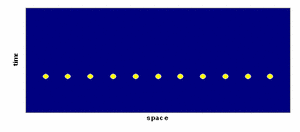
To render this picture relativistically correct, we need to 'bend' the trajectories such that the angle with the vertical (time) axis stays smaller than the angle corresponding to the speed of light. This bending corresponds to the well-known relativistic time dilation: time runs more slowly for fast moving objects. So we imagine that each of the galaxies carries a clock that started ticking at the moment of the big bang, and plot the positions of the galaxies when all galactic clocks show the same time. We get the following picture:
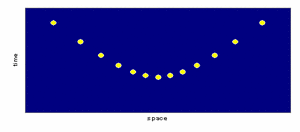
Notice that the time indicated along the vertical axes is associated with the central galaxy in this picture. From the perspective of this central galaxy, galaxies further away move faster and their clocks tick slower, and therefore they reach a given position only when the clock of the central galaxy indicates a much later time. This causes the 'bending up' of the line of galaxies. By plotting all galaxies at synchronized proper (cosmological) times, we effectively have relativistically mixed space and time and created a curved space (yellow band) that stretches itself more straight with time:
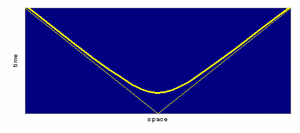
Notice that in this picture the big bang (cosmic time zero) is represented by two straight lines: two opposing flashes of light filling whole space.
We are now ready to indicate the visible universe as seen from the galaxy central in the picture. These are nothing more than the rays of light traveling from the past and ending at the central dot. In a one-dimensional universe there are two such light rays, indicated by the green line segments in below figure. To render this visualization more complete, the early opaque phase of the universe (denoted in yellow) is distinguished from the transparent phase. The interface between the two represents the 'surface of last scatter'. This surface marks the visible depth of the universe. It is visible as the cosmic microwave background, the afterglow of the big bang discovered in 1964 and mapped out by the COBE and WMAP satellites.
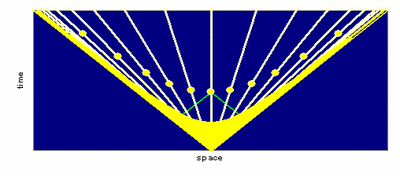
Again: the Cosmological Principle
Ok, so if you want to imagine the big bang as some sort of explosion, the correct picture is shown above. It honors the theory of relativity, yet is a caricature of 'the real thing' as only one space dimension is represented, and the effects of gravity are ignored. Its qualitative features, however, are correct.
But wait a second. What about the cosmological principle? Surely this principle is grossly violated: the galaxy in the center of the picture surely occupies a very special place in this one-dimensional universe. Ptolemy would perhaps like this model, but Copernicus and Galilei certainly wouldn't.
Not too quick! This is where the magic of Einstein's theory of relativity comes into play. In the above picture the central galaxy seems special, but that is only so because we have represented the universe from the perspective of this particular galaxy. We can 'scroll' through this one-dimensional universe and experience a universe that looks the same from each alternative perspective:
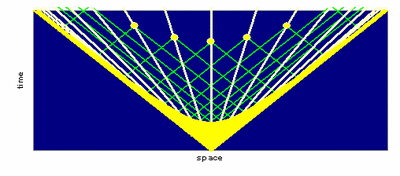
Clearly each galaxy occupies an equivalent position. Our one-dimensional model universe obeys the cosmological principle in the most detailed way possible. Each point in this universe is at the center of it. It is just a matter of perspective.
Also obvious from this picture is that the 'scrolling' can be continued indefinitely. This universe is truly infinite. However, from the perspective of each galaxy, the observable universe (the green light rays emanated from the surface of light scatter and illuminating the galaxy) is finite. Note, however, that different galaxies have different observable universes associated with them.
There is much more to be said about this model universe. But let me stop here, and ask you a concluding question: do you accept the big bang? Do you consider it a truth like you consider a non-flat earth a truth?If not, have you ever wondered why the night is dark?




Comments